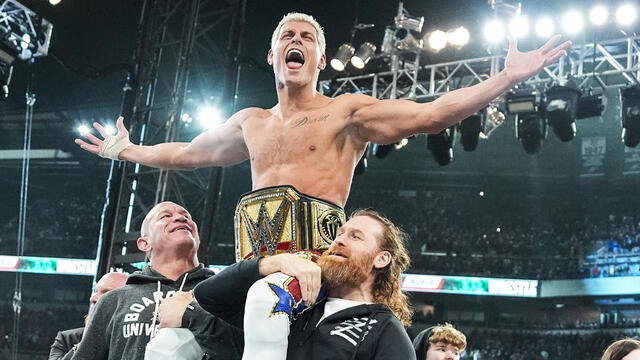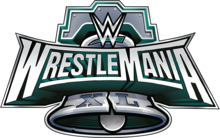
Six Things You Didn’t Know About Survivor Series

Since its arrival in 1987, Survivor Series has been one of WWE's most momentous events, and in the 25 years that have passed, its historical importance has only grown. What began as a perhaps quirky, survival-themed pay-per-view that aired Thanksgiving night has evolved into WWE’s second longest-running event.
The fall classic has played home to major title matches and a wide assortment of dramatic twists and turns, not to mention a turkey of an idea or two. (Gobbledy Gooker, we’re looking in your direction.) Rediscover some of the lesser-known incidents, matches and moments that helped make Survivor Series among the most beloved and widely anticipated shows of the year.
The Casket Match, Elimination Chamber and Ambulance Match premiered there
For years, the Survivor Series event was defined by one match type: the traditional Survivor Series tag match, in which teams of five (and occasionally four) warred in a single-elimination format. Once the mix was broadened to include other match types, a wave of new and innovative stipulation bouts came into existence.
In 1992, The Undertaker downed Kamala in WWE’s first Coffin Match, a precursor to the Casket Match. (Unlike its more famous spinoff, in which a Superstar wins by putting his opponent in a casket and closing the lid, the Coffin Match ends once a Superstar has been stuffed into a coffin and the lid has been nailed shut. Technicalities, people.) ( WATCH)
The scaling back of traditional Survivor Series Matches paved the way for other inventive stips, too: ex-corrections officer Big Boss Man defeated ex-con Nailz in a Nightstick-on-a-Pole Match, also at Survivor Series 1992. Jumping ahead to 2003, Kane bested Shane McMahon in WWE’s inaugural Ambulance Match. Taking the cake for Survivor Series match innovation, however, must be the Elimination Chamber — a devastating structure that was first unleashed at Survivor Series 2002 and eventually turned into an annual pay-per-view of its own.
And that’s not even counting the traditional Survivor Series matches that had their own unique twists, such as the “Grand Finale Match of Survival” in 1990 (in which the winners of all the evening's bouts met in a final Survivor Series Match) and the Wild Card Survivor Series Match in 1995 (where opposing teams were picked at random, resulting in uneasy partnerships between, for example, then-rivals Dean Douglas and Razor Ramon).
Survivor Series was the first WWE pay-per-view to feature a non-WWE title
The NWA North American Title was put on the line at WWE In Your House: No Way Out of Texas in February 1998 and the resurrected ECW Heavyweight Title was defended on pay-per-view numerous times during the company’s brief revival from 2006 to 2010. But the very first WWE pay-per-view to see a non-WWE championship match was Survivor Series 1993.
The bout, a tag team match between The Heavenly Bodies (Tom Prichard & Jimmy Del Ray) and The Rock ‘n’ Roll Express (Ricky Morton & Robert Gibson), was fought for the tag titles belonging to Tennessee-based territory Smoky Mountain Wrestling. Arranged by Smoky Mountain mastermind and Heavenly Bodies manager James E. Cornette, the matchup between the longtime SMW rivals was mired in controversy for its result. Prichard & Del Ray won the titles from Morton & Gibson, but not until after Morton had been disposed over the top rope — grounds for disqualification had the match been wrestled under SMW rules instead of WWE rules.
The Undertaker, The Rock and Flash Funk all debuted there
WrestleMania may be The Birthplace of Legends, but Survivor Series holds its own in the “Superstar debut” category. WWE’s fall classic is where The Undertaker broke in as a mystery member of Ted DiBiase’s Million Dollar Team in 1990. ( WATCH) Six years later, inside the hallowed Madison Square Garden, the WWE Universe got its first glimpse of international tag team standouts Doug Furnas & Phil Lafon, as well as 2 Cold Scorpio, who made his WWE premiere as Flash Funk. Those WWE debuts are a historical footnote, however, in comparison to another WWE rookie who showed up that night: The Rock.
Not to be overlooked is Survivor Series 1997, which featured Kane’s and Steve Blackman’s first official WWE matches, and Survivor Series 1999, which saw the in-ring debut of Olympic gold medalist and eventual WWE Champion Kurt Angle.
This all goes to prove that Survivor Series has long been an attractive event where Superstars lay the foundation of great careers.
The first Survivor Series was a power play that put NWA Starrcade on its heels
When you see the words “power play” and “Survivor Series” together, it’s natural to first think of either the Montreal incident from 1997 or the crowning of a “Corporate Champion” in 1998. However, the first Survivor Series, all the way back in 1987, held significance for reasons other than becoming the second of the eventual “Big Four” tent pole events on WWE’s pay-per-view calendar.
Held Thanksgiving night 1987, the initial Survivor Series served as powerful counterprogramming to the rival National Wrestling Alliance’s annual Starrcade supercard, which was finally graduating from closed-circuit broadcast to pay-per-view, a relatively new beast at the time. The showdown — the first and only time WWE and the NWA went head-to-head on pay-per-view — put cable operators in a precarious position, having to choose between airing either the NWA’s long-established event or WWE’s brand-new creation.
Ultimately, cable providers overwhelmingly opted to broadcast Survivor Series and the blow was a devastating setback to the NWA and Starrcade’s host company, Jim Crockett Promotions. The rest, as they say, is history.
Shawn Michaels, Bret Hart and British Bulldog teamed in a 20-man tag match
In WWE in the 1990s, three Superstars repeatedly crossed each others’ paths in high-profile rivalries: Hall of Famers Shawn Michaels and Bret Hart and WWE Legend British Bulldog. But did you know that all three warriors once competed on the very same team?
The strange-but-true occurrence happened at Survivor Series 1988 during a massive traditional Survivor Series Match fought among WWE’s top tag teams. The match featured 20 Superstars in total, and HBK, Hart and Bulldog were competing as members of their respective tag teams (Michaels’ Rockers team with Marty Jannetty, Hart’s Hart Foundation team with Jim Neidhart, and Bulldog’s partnership with Dynamite Kid). Though their opposition ended up winning that night — The Powers of Pain (The Warlord & The Barbarian) were the bout’s only “survivors” — that all three tag specialists-turned-singles icons found themselves on the same side, even once, is noteworthy.
After all, it was only four years later that Bulldog and Michaels were engulfed in individual rivalries over the Intercontinental Championship. Later, all three competed over the WWE Title. The 1988 Survivor Series match was also the first of several matches in the event’s history involving both The Showstopper and “Hit Man.” After teaming together in 1988, they competed against each other in singles matches in 1992 and 1997, and they captained opposing Survivor Series teams in 1993.
John Cena’s undefeated there
In his seven appearances there as a competitor, the Cenation leader has owned Survivor Series each time out. The perfect 7-0 record represents a mixture of victories in traditional Survivor Series matches (in which Cena never lost a fall) and high-profile title matches. He has competed in three traditional elimination matches, including one appearance as a team captain in 2006.
As WWE Champion, he defeated Kurt Angle in 2005. Cena did not compete at the 2007 installment of Survivor Series, but he returned in 2008 — in Boston, no less — to unseat Chris Jericho as World Heavyweight Champion. In 2009, the Cenation leader scored a massive win in a Triple Threat Match, beating Shawn Michaels and Triple H to retain the WWE Title. The following year, Cena was again out of action (though he did serve as the special referee in Survivor Series 2010’s WWE Title main event between then-champion Randy Orton and Wade Barrett). In 2011, of course, Cena teamed with his WrestleMania XXVIII opponent, The Rock, to put away The Awesome Truth.
Can Cena continue his trend of perfection at WWE's fall classic this year? ( HOW TO WATCH)
WWE Shows Latest Results
Raw results, April 15, 2024: Chad Gable viciously attacks Sami Zayn after losing to Zayn in Intercontinental Title Match!
Full ResultsSmackDown results, April 12, 2024: LA Knight and AJ Styles earn victories for a chance to challenge Cody Rhodes at WWE Backlash!
Full ResultsWWE NXT results, April 16, 2024: Trick Williams defeats Carmelo Hayes in a Steel Cage Match
Full Results


















